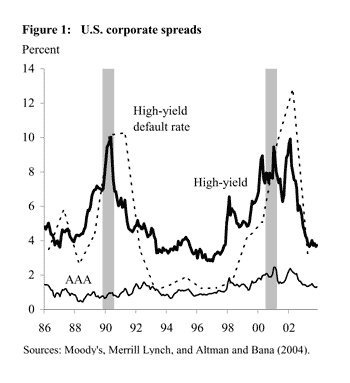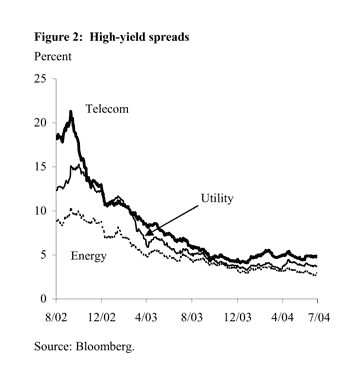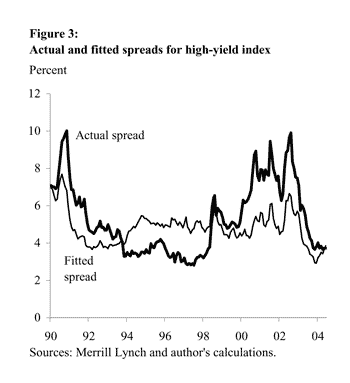Although the swings in economic measures during the last recession and recovery were fairly modest, swings in financial markets were quite large. Once financial markets found their footing, after steep losses in 2000-2002, prices on virtually all traded financial claims rose as the economic outlook improved.
- The corporate bond market
- Recent behavior of credit spreads
- Determinants of corporate spreads
- Conclusion
- References
Although the swings in economic measures during the last recession and recovery were fairly modest, swings in financial markets were quite large. Once financial markets found their footing, after steep losses in 2000-2002, prices on virtually all traded financial claims rose as the economic outlook improved. This pattern was particularly true in the corporate bond market. In this Economic Letter I describe the significant narrowing of bond spreads across different sectors and ratings classes since the last recession. I also discuss recent research on the determinants of relative pricing in the corporate bond market.
A corporate bond is a debt instrument issued by a legal corporate entity. Bonds differ across many dimensions, including maturity, collateral, and whether there is any optionality such as a call provision embedded in the bond. Typically, corporate bonds have maturities longer than 2 years. Shorter-term debt instruments include commercial paper (less than 270 days) and medium-term notes.
The U.S. corporate bond market is large, with $6.8 trillion in outstanding corporate and foreign debt (that is, dollar-denominated debt issued in the U.S.) in the fourth quarter of 2003. This total is about two-thirds the amount of outstanding U.S. Treasury debt and five times the amount of outstanding business loans at banks in the U.S. The growth rate of net corporate debt issuance is approximately 12% per year since 1980, and appears to be less variable than the net growth in business loans at banks.
Corporations differ in their creditworthiness, and these differences are apparent in the pricing of their bonds, as well as in whether a particular firm is able to issue debt through the public markets at all. Private ratings agencies (such as Moody’s and Standard & Poor’s) provide guidance to investors on the credit quality of various bond issues. The Standard & Poor’s ratings scale ranges from the more creditworthy investment grade debt (roughly BBB, A, AA, and AAA) to less creditworthy speculative-grade debt (roughly CC, CCC, B, BB). Today, approximately one-half of the rated corporate bonds outstanding are BBB or better.
Recent behavior of credit spreads
 A bond’s value is usually quoted not in terms of its traded price, but in terms of its yield, or the annualized holding period return if an investor held the bond to maturity. Like yields on Treasury securities, corporate bond yields embody a reward to investors for forgoing consumption today and saving. But corporate yields are almost always higher than yields on Treasuries of comparable maturities because of the implicit default risk and a host of other factors. The corporate spread, or sometimes just the credit spread, is usually measured as the difference between the yields on a defaultable corporate bond and on a U.S. government bond of comparable time to maturity.
A bond’s value is usually quoted not in terms of its traded price, but in terms of its yield, or the annualized holding period return if an investor held the bond to maturity. Like yields on Treasury securities, corporate bond yields embody a reward to investors for forgoing consumption today and saving. But corporate yields are almost always higher than yields on Treasuries of comparable maturities because of the implicit default risk and a host of other factors. The corporate spread, or sometimes just the credit spread, is usually measured as the difference between the yields on a defaultable corporate bond and on a U.S. government bond of comparable time to maturity.
Figure 1 plots the behavior of various U.S. credit spreads and clearly shows that credit spreads tend to widen in recessions and to shrink in expansions. The figure also illustrates an episode where the spread changed in response to an event that was not immediately related to the business cycle, specifically, the Russian default in 1998. This event triggered a huge move in spreads, as markets seized up in a liquidity crisis, even though the U.S. corporate bond market did not see a significant jump in defaults.
Given the large change in credit spreads over the past two years, it is useful to identify the sectors and risk classes behind the improving conditions in the bond market. I focus on high-yield bonds, the segment with the largest fluctuations over the period. I use the Merrill Lynch High-yield Master, which consists of 1,966 bonds rated BB or lower. All spreads are calculated as the difference between a corporate yield and the yield on the 10-year constant maturity Treasury note.
 Figure 2 plots the time-series of spreads in some sectors that comprise the high-yield index. The energy, telecom, and utility sectors have the largest representation in the High-yield Master today, each accounting for about 10% of the index. Figure 2 depicts the narrowing in spreads following the 2001 recession, with spreads on telecoms falling the most, from a high of 21 percentage points in October 2002 to just 5 percentage points in July 2004. High-yield bonds in the energy sector once traded at spreads of 10 percentage points, but now have spreads of closer to 3 percentage points, a mere 1 percentage point over the AAA spread.
Figure 2 plots the time-series of spreads in some sectors that comprise the high-yield index. The energy, telecom, and utility sectors have the largest representation in the High-yield Master today, each accounting for about 10% of the index. Figure 2 depicts the narrowing in spreads following the 2001 recession, with spreads on telecoms falling the most, from a high of 21 percentage points in October 2002 to just 5 percentage points in July 2004. High-yield bonds in the energy sector once traded at spreads of 10 percentage points, but now have spreads of closer to 3 percentage points, a mere 1 percentage point over the AAA spread.
Determinants of corporate spreads
Why does the difference between yields on speculative-grade debt and investment-grade debt vary by almost 10 percentage points over the course of a fairly run-of-the-mill business cycle? One possibility is that distinctions between ratings classes change over the business cycle, so that the difference in default risk between, say, a BBB-rated bond and an AA-rated bond is less in good economic times than in bad. The evidence does not support this conclusion, however. Measures of a company’s probability of default do not appear to be as variable as the credit spread over time. Indeed, there is now an established literature on estimating just how much of the so-called credit spread is due to credit or default risk. To get a sense of the range of estimates, Amato and Remolona (2003) note that average BBB corporate spreads were nearly ten times higher than average losses from default between 1997 and 2003. Using more sophisticated statistical methods, Elton et al. (2001) report that expected losses from default can account for less than 20% of the credit spread. Finally, Longstaff et al. (2004) estimate that default risk accounts for more than 50% of the credit default swap spread.
Though there is a range of estimates on the size of the non-default risk component, it is generally accepted now that there is more to the corporate spread than just credit risk. This observation has led researchers to search for other determinants of the spread. One other obvious difference between corporate bond yields and government bond yields is their tax treatment; interest income paid on corporate bonds, but not government bonds, is taxable at the state level. The top marginal state tax rates generally range from 5%-10%. Elton et al. (2001) find that, depending on the ratings class, taxes can account for anywhere from one-quarter to three-quarters of the difference in the spread between corporate and government bonds.
Another difference is that the credit spread contains some compensation for the general illiquidity of the bond market. Investors typically incur larger round-trip trading costs in the corporate bond market than in the U.S. equity market. But market liquidity is not constant over time. The recent performance of corporate bonds offers a nice opportunity to see this point. As the economy weakened and default rates spiked, investors allegedly reduced their demand for high-yield securities and sought safe-haven investments. In order for the market to clear, spreads on corporate bonds had to widen. As the general economic weakness became apparent, however, monetary policy became very accommodative. The extended period of low interest rates and the recovery presumably increased liquidity to the high-yield sector, and spreads converged.
One way to get a rough estimate of the size of this liquidity effect is to estimate a relationship between the yields on corporate bonds and variables meant to proxy for current and future economic health of firms. Lacking a good variable with which to identify the aggregate risk or liquidity premium for the bond market, the deviation of the actual spread from the model-predicted spread can be interpreted as an upper bound for this component of the spread.
I start with a simple model to explain the monthly change in spread of the Merrill Lynch High-yield Index over the 10-year Treasury yield. The model is similar in spirit to the one estimated by Collin-Dufresne et al. (2001); the main difference is that this model uses an aggregate index, and not a collection of individual corporate bonds. The variables used to explain the change in the high-yield spread are the previous monthly change in the spread, the last month’s level of the spread, the monthly return on the S&P 500, and the change in the S&P 100 volatility index (a measure of stock market investor uncertainty about future stock returns). Other lags of the spread and other economic variables were considered, such as the change in the federal funds rate, the change in the speculative-grade default rate, and the change in the slope of the risk-free term structure. But these variables proved to add little to the specification after the other variables were already in place. Presumably, the change in the default rate failed to be significant in the model because of the inclusion of the lagged spread terms and the more forward-looking stock market variables that should capture expectations of future default rates.
 The model includes variables that account for the general economic conditions and future assessments of risk. Figure 3 shows the actual high-yield spread compared to the “fitted spread,” or the spread generated by the model. The fitted spread moves with the actual spread, indicating that the choices of variables to proxy for the economy seem to be well-founded. But the fitted spread is not as variable as the actual spread. In bad economic times, investors require more compensation for risk than can be accounted for by the fundamentals in this model. Likewise, in good economic times, actual spreads tend to be lower than those predicted by the model. These estimates should be viewed as back-of-the-envelope, and do not imply mispricing; they do, however, illustrate in a simple way that a large portion of the credit spread cannot be explained by previous dynamics in the spread, or by reasonable proxies for risk captured in stock market variables. Moreover, the deviation of the model-based spread seems to be related to the cycle.
The model includes variables that account for the general economic conditions and future assessments of risk. Figure 3 shows the actual high-yield spread compared to the “fitted spread,” or the spread generated by the model. The fitted spread moves with the actual spread, indicating that the choices of variables to proxy for the economy seem to be well-founded. But the fitted spread is not as variable as the actual spread. In bad economic times, investors require more compensation for risk than can be accounted for by the fundamentals in this model. Likewise, in good economic times, actual spreads tend to be lower than those predicted by the model. These estimates should be viewed as back-of-the-envelope, and do not imply mispricing; they do, however, illustrate in a simple way that a large portion of the credit spread cannot be explained by previous dynamics in the spread, or by reasonable proxies for risk captured in stock market variables. Moreover, the deviation of the model-based spread seems to be related to the cycle.
The narrowing of corporate bond spreads across virtually all ratings classes and business sectors is a strong vote of confidence in the economic recovery. However, the episode also serves as a reminder of the keen research interest in the determinants of corporate bond spreads. High-yield spreads are clearly tied to fundamentals such as future expected default rates. But spreads are also related to market liquidity in ways that are not yet well understood.
John Krainer
Economist
References
[URLs accessed November 2004.]
Altman, E., and G. Bana. 2004. “Defaults and Returns on High-Yield Bonds.” Journal of Portfolio Management (Winter) pp. 58-73.
Amato, J., and E. Remolona. 2003. “The Credit Spread Puzzle.” BIS Quarterly Review (December) pp. 51-63.
http://www.bis.org/publ/qtrpdf/r_qt0312.pdf
Collin-Dufresne, P., R. Goldstein, and S. Martin. 2001. “Determinants of Credit Spread Changes.” Journal of Finance 56, pp. 2,177-2,208.
Elton, E., M. Gruber, D. Agrawal, and C. Mann. 2001. “Explaining the Rate Spread on Corporate Bonds.” Journal of Finance 56, pp. 247-277.
Longstaff, F., S. Mithal, and E. Neis. 2004. “Corporate Yield Spreads: Default Risk or Liquidity? New Evidence from the Credit-Default Swap Market.” Working Paper 11-03, UCLA. http://www.anderson.ucla.edu/documents/areas/fac/finance/11-03.pdf
Opinions expressed in FRBSF Economic Letter do not necessarily reflect the views of the management of the Federal Reserve Bank of San Francisco or of the Board of Governors of the Federal Reserve System. This publication is edited by Anita Todd and Karen Barnes. Permission to reprint portions of articles or whole articles must be obtained in writing. Please send editorial comments and requests for reprint permission to research.library@sf.frb.org